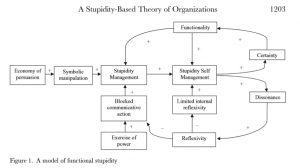TSElosophers meeting on 19.12.2023. Participants: Behnam Pourahmadi, Erkki Lassila, François-René Lherm, Kari Lukka, Mia Salo, Milla Unkila, Otto Rosendahl
Gill, M. J. (2014) The Possibilities of Phenomenology for Organizational Research. Organizational Research Methods, Vol. 17(2) 118-137.
Summary
Michael Gill argues that phenomenological methodologies exploring how people experience particular phenomena (p. 130), like organizational identity, are especially powerful in understanding subjective experiences and meanings. Hence, organizational research could benefit from utilizing more of them. To further this project, Gill develops a typology that classifies and contrasts five phenomenological methodologies originating from the disciplines of psychology, pedagogy, nursing, and organization studies. Each of these five methodologies is based on Husserlian descriptive or Heideggerian interpretive phenomenology, or a combination of them. Gill regards this philosophical distinction as foundational for distinguishing between different phenomenological methodologies. Additionally, by specifying aims, participants and sampling strategy, key concepts of data collection and analysis, of each methodology (p. 122, 127), Gill offers guidelines for researchers to select a suitable one for their research purposes.
Discussion
As a whole, we welcomed Gill’s paper as it reminds organizational scholars of the phenomenological approach’s historical and current significance to our field, and of the fact that there is no standard phenomenological methodology, but instead, a variety of them. We also appreciated Gill’s effort in developing and presenting a classification of the most popular phenomenological methodologies across disciplines. However, above all, the paper lacked a more thorough analysis of the intriguing divide between Husserlian descriptive and Heideggerian interpretive approaches to phenomenological philosophy.
In Gill’s presentation, this foundational divide underlying his classification of phenomenological methodologies is, at first glance, a kind of taken-for-granted fact that he brings forth only shortly, without much justification. According to Gill (p. 119-120), the Husserlian approach aims to describe the essence of experiences through the method of phenomenological reduction (epoché). In contrast to Husserl’s epistemological focus, Gill argues that the Heideggerian approach has an ontological one (p. 120). In other words, Heidegger aims to explore the human experience of being (Dasein) and, for this purpose, employs his hermeneutic, i.e. interpretive method. Ultimately, the difference between Husserl’s reduction and Heidegger’s hermeneutics lies in whether a “fully detached reflection” (ibid.) is possible, that is, whether we can be free of assumptions or not.
We followed this line of thought but considered it as a rough generalization of both Husserl’s and Heidegger’s phenomenologies that both draw on distinctive ontological and epistemological assumptions. Specifically, we would have appreciated the notion of intentionality – the directedness of an experience or ‘consciousness of’ – to have been discussed in the paper and the role of subjective meanings to have been addressed in more detail. Concerning the classification of methodologies, many of us see a fruitful future study subject in how the aims of different methodologies relate to a more specified analysis of phenomenological philosophy (see Table 1 p. 122).
One of the main discussion points was the question, ignored by both Gill and many others tracing the origins of phenomenology to Husserl, of whether or not Husserl should indeed be considered the forefather of phenomenology considering his rather non-subjectivist suppositions. Both the act and the possibility of bracketing, and his insistence of there being something “essential” that can be derived through reduction seemed to some of us more reflective of the exactly opposite viewpoint that can be considered as the apparent strength of phenomenology – its emphasis on the subjectivity, contextuality and experience. In turn, Heidegger embodies these principles, and especially his notion of ‘Dasein’ seemed to some of us to maybe even be one of the earliest inklings of what has since become complex and adaptive systems thinking: the idea that the observer and the observed are part of one entity fully understandable only through accounting for their interconnectedness.
These ponderations lead one TSElosopher to even entertain the idea of renaming phenomenology as “noumenology”. Kant viewed phenomenon as such knowledge object that contained both the noumenal idea of the thing, and the sensory experience the thing yielded, essentially thus referring only to such things that had a form that could be seen, touched, or maybe heard. In contrast, a thing that had no such form was in Kant’s parlance a noumena (he used God as an example) that could be positive or negative depending on whether or not its existence was true or not. On the one hand, considering that phenomenological approaches focus explicitly on things without a form detectable by senses (like meaning, organization or organizational identity as suggested by Gill – in short, noumena), it raises the question of the origins of the label. On the other hand, the etymology of the label refers to “that, which is being made to appear” (passive, present participle of ‘phaino’), which suggests that a phenomenon is distinct from a noumenon in so far as it may be made to appear by the intentionality exercised upon it. Perhaps Wittgenstein was considering the complexity of intention and its acquaintance with both the existence of a phenomenon and our ability to know it when he stated “There is no such thing as phenomenology, but there are indeed phenomenological issues”[1] (1977, §53 and 248)
To conclude, we agree with Gill’s assertion that a “phenomenological researcher’s epistemological and ontological assumptions should inform his or her selection of a particular methodology” (p. 127). However, we suggest the researcher builds their choice on a more profound basis of phenomenological philosophy than presented in this article – as Michael Gill’s paper stresses in its conclusions.
[1] Es gibt zwar nicht Phänomenologie, wohl aber phänomenologische Probleme.”
